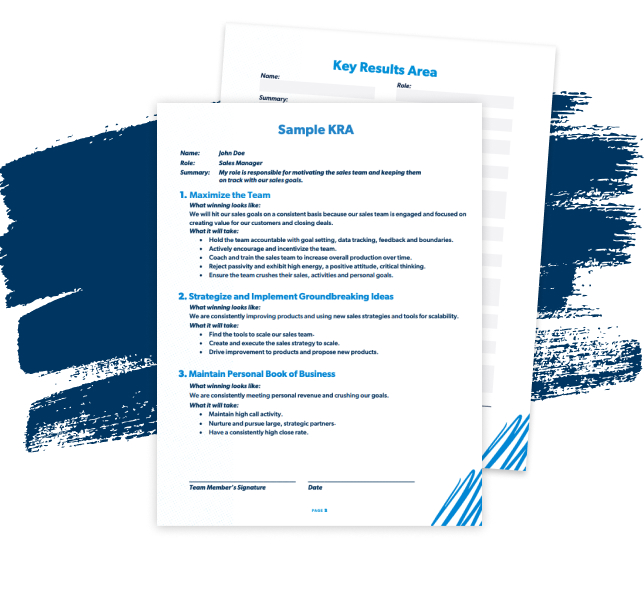Key Takeaways
- Accountability isn’t micromanagement. Micromanagement kills trust and slows your team down. Accountability is about setting clear expectations and providing support—not controlling every detail.
- Clear expectations are the foundation. Without them, accountability feels frustrating and confusing for everyone.
- Set expectations that stick. Define what winning looks like, empower your team, and ask for commitment.
- Regular feedback matters. One-on-one meetings and team check-ins reinforce accountability and prevent misalignment.
- Accountability should be measurable. Self-assess, get team feedback, and check for signs your systems are working.
Quick—what comes to mind when you think about holding your team members accountable? For some leaders, accountability feels like the ultimate power trip. You can almost hear them demanding their team members bow before their scepter of control.
For others, accountability feels like forced babysitting—complete with awkward, unproductive conversations about productivity. Ironic. (And that’s still not an accurate understanding of accountability.)
The truth is, real accountability isn’t at all about flexing authority, being the bad guy, or micromanaging every move. It’s about empowerment, clarity and support.
Ignore accountability and your team will flounder, miss deadlines, and wonder who’s actually in charge. Embrace it the right way and professional accountability will help your team stay focused and moving in the right direction.
So what exactly does that kind of accountability look like? Let’s redefine accountability, look at signs of its evil twin—micromanagement—then explore how to hold employees accountable without micromanaging.
What Accountability Really Is (and Isn’t)
Accountability at work is the repeated pattern of verifying that expectations are turning into results. Think of it as a routine, conversational check-in. Done well, accountability makes your team feel supported, not interrogated.
Here’s another important distinction: Accountability and consequences sometimes go hand in hand, but they aren’t the same thing. Consequences come into play when expectations aren’t met—that’s when you have to step into the discomfort and address what’s off. But accountability itself serves as your vote of confidence in the person doing the work. It celebrates progress and gives your team members support so things don’t go off the rails. Hint: If accountability feels high-stakes or negative, you’ve lost the plot.
Unfortunately, that happens a lot. Too often, accountability is either nonexistent—just the occasional “So . . . how’s that project coming?”—or it’s handled terribly, as in blaming, nitpicking or hovering over every detail instead of trusting your team to do their jobs. That sounds a lot like micromanaging because it is.
So how do you know if you’re slipping to the dark side of leadership in the name of accountability? Here are some telltale signs.
7 Signs You Might Be a Micromanager
- You're constantly checking in instead of letting your team own their work.
- You redo tasks because they aren’t done your way.
- Your team hesitates to make decisions without your approval.
- You have an unspoken expectation that the only “right” way is your way.
- You rarely delegate because it’s easier to do it yourself.
- You focus more on how something is done rather than what gets done.
- You struggle to step away from work without worrying about what’s happening in your absence.
Unless you want to be the boss nobody likes to work with, stay far, far away from micromanagement. It’s not just annoying—it’s destructive. Here’s why:
- It slows your team down. People won’t take initiative if they’re always waiting on you or trying to second-guess your next move.
- It kills trust and morale. No one likes feeling like they’re being watched 24/7 or can’t do their job.
- It burns you out. Trying to control everything is exhausting. Many hands make light work (and make scaling your business possible).
Clear Expectations: The Foundation of Accountability in the Workplace
Once you wrap your head around real accountability, it feels way less intimidating. Who doesn’t want to help their team win? But to get there, you need this trusty sidekick: clear expectations.
In fact, holding people accountable should only take up about 1% of your emotional energy. The other 99%? That’s for setting clear expectations.
And no, we’re not talking about barking orders or dropping backhanded comments in hopes your team will read your mind. Yuck! Setting clear expectations is a two-way conversation—one that brings clarity for everyone and gets team buy-in toward shared goals.
When you set expectations correctly, you’re really saying, “I believe you can do this.” And that kind of confidence feels amazing to your team. Instead of pointing out weaknesses or failures, you’re calling out strengths and empowering them to get stuff done. But when expectations aren’t clear, that confidence turns into confusion—and that’s when problems start.
Common Expectation Traps
- Imagined expectations: Your team assumes you expect something you never actually communicated.
- Outside expectations: A request from another department blindsides your team because you didn’t warn them.
- Unspoken expectations: Your sighs and facial expressions make people think they’re failing—but they have no idea why.
To avoid these time-wasters, have your team tell you what they think you expect. Then clarify what’s real and what’s just assumed. Once you’ve eliminated guessing games, you’re ready to set expectations that stick. Here’s are four keys.
4 Keys to Setting an Expectation That Sticks
- Frame it. Clearly explain the expectation, why it matters and why your team member is the right person for the job.
- Empower them. Define their level of authority to do the work and make sure the rest of the team knows too. Clarity reduces friction.
- Measure it. Make sure they understand what winning looks like. What will tell them (and you) they’ve met the expectation?
- Commit to it. Ask them if they fully understand the expectation and feel empowered. Then look them in the eyes (yes, it might feel awkward) and ask, “Do you commit?” That simple question reinforces ownership.
How to Hold Your Team Accountable (Without Micromanaging)
Now that you understand the accountability-expectation partnership, let’s get into the practical side of how to hold employees accountable without micromanaging. Simply put, it’s all about these four non-negotiables:
- Set expectations first. Before you hold someone accountable, make sure they fully understand what you’re aiming for, why it matters, and what success looks like.
- Create a strong feedback loop. Team member weekly reports are a great tool your team can use to share their wins and where they need support. They also help you gauge how your team is managing their workload and whether expectations need to be clarified.
- Give real-time insights. Waiting until an annual review to address concerns? Bad idea. Regular one-on-one meetings create a rhythm for celebrating progress or course-correcting when needed in the moment. They’re also a great place for team members to talk through expectations—whether real or imagined—so everyone can move forward with clear hearts and the right focus.
- Clarify ownership. Make sure each team member has outlined their Key Results Areas (KRA). This simple, one-page document summarizes their top three to five responsibilities, the outcomes they’re accountable to, and what winning looks like in their roles.
Free KRA Template
Want an easy way to create KRAs for your team members? Grab our free template, plus get a couple examples of completed KRAs for reference!
Last Step: Make Accountability Measurable
Accountability isn’t just a gut feeling—it’s something you can track. Here’s how:
- Self-assessment: Be honest. Where are you winning and losing at setting expectations and creating accountability?
- Feedback: Let your team anonymously weigh in on how well you’re communicating expectations and holding them accountable. Their perspective is valuable—even if it stings.
- Team assessment: Answering these questions honestly will show you how you're doing with accountability basics.
- Do you do one-on-ones regularly?
- Are your direct reports’ key responsibilities up to date?
- Are annual reviews happening on time (without surprises)?
- Do you check in with team members when frustrations arise?
Holding your team accountable doesn’t have to feel awkward or make you the bad guy. As you do it right, it becomes a natural, even positive, part of how your team works together—free of micromanaging.
What’s Next: Clarify Expectations and Lead With Real Accountability
- Download the KRA Template to help you create clear expectations for your team.
- Join EntreLeadership Elite, the online platform used by thousands of business leaders with tools, trainings and coaching to help you be a leader people want to follow.


